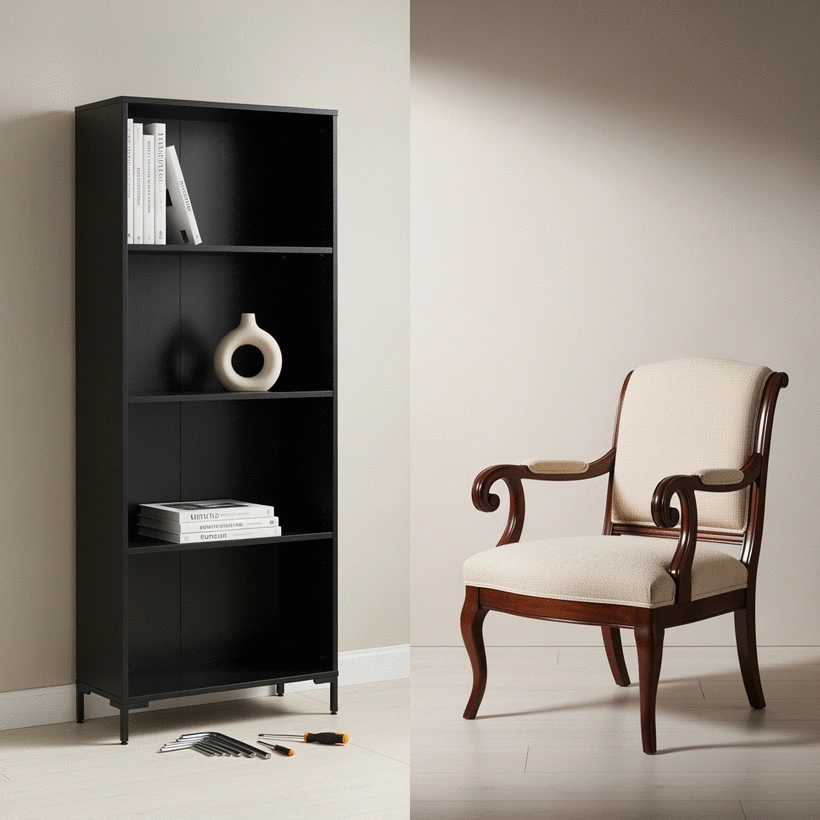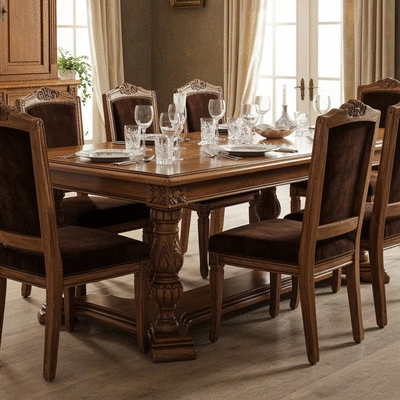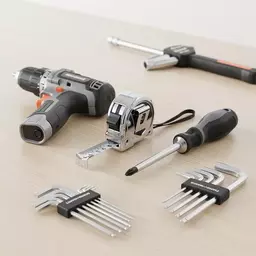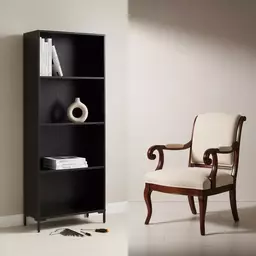Flatpack or Traditional Furniture?

Have you ever found yourself torn between the sleek convenience of flat-pack furniture and the timeless allure of traditional craftsmanship? Understanding the nuances of these options can transform your home and your assembly experience. Let’s explore the distinct characteristics that define each type of furniture and help you make an informed choice!
What You Will Learn
- Flat-pack furniture is cost-effective, making it an appealing option for budget-conscious consumers.
- Traditional furniture offers superior durability, often crafted from solid wood that lasts for generations.
- IKEA has significantly influenced the popularity of flat-pack furniture by combining style and affordability.
- Each furniture type caters to different lifestyles, with flat-pack being ideal for small spaces and DIY enthusiasts.
- Understanding customer reviews can provide valuable insights into the performance and quality of furniture choices.
- Sustainability is becoming increasingly important, with many brands now prioritizing eco-friendly materials in their products.
Flat-Pack vs. Traditional Furniture: A Comparative Overview
This visual compares the key characteristics of flat-pack and traditional furniture, highlighting their pros, cons, and typical user sentiments to aid in your decision-making process.
Flat-Pack Furniture Overview
Pros:
- Affordable & Budget-Friendly
- Easy to Transport (Compact)
- Wide Variety of Styles & Designs
- DIY Assembly Experience
Cons:
- Assembly Can Be Time-Consuming
- Potentially Less Durable
Customer Sentiments:
"Great value for money! Assembly was straightforward."
Traditional Furniture Overview
Pros:
- High Durability & Longevity
- Artisan Craftsmanship & Unique Details
- Robust & Stable Construction
- Timeless Appeal & Character
Cons:
- Higher Price Point
- Less Convenient for Transport
Customer Sentiments:
"Incredibly sturdy and well-made. Worth the investment!"
Understanding Flat-Pack and Traditional Furniture: Key Definitions and Differences
When it comes to furnishing our homes, we often face the choice between flat-pack and traditional furniture. Understanding these two categories is essential for making an informed decision that suits your lifestyle and needs. In this section, I’ll dive into what flat-pack furniture is, how it became popular, and how it contrasts with traditional craftsmanship.
What is Flat-Pack Furniture and Its Popularity?
Flat-pack furniture refers to a type of furniture that comes in a box, accompanied by assembly instructions. The parts are usually pre-cut and designed for easy transport and self-assembly. Its popularity has soared in recent years, especially among young adults and city dwellers. Why? It’s affordable, space-efficient, and allows for a bit of DIY creativity! For more in-depth guidance on setting up your furniture, check out our article on assembling flat-pack furniture.
- **Affordable:** Generally cheaper than traditional options.
- **Space-efficient:** Perfect for smaller living spaces.
- **DIY experience:** Engaging and rewarding to assemble.
People are drawn to the idea of creating their own furniture, and I think that's wonderful! It allows for personalization and the satisfaction of completing a project. Plus, flat-pack furniture often offers various styles and options to fit different tastes.

Defining Traditional Furniture and Its Craftsmanship
Traditional furniture is typically made from solid wood or high-quality materials, carefully crafted by skilled artisans. The craftsmanship involved in producing these items can be quite impressive, often reflecting the unique design and durability associated with handcrafted pieces.
- **Quality materials:** Usually made from solid wood, enhancing longevity.
- **Artisan craftsmanship:** Each piece exhibits unique details.
- **Timeless appeal:** Classic designs that can elevate any space.
While traditional furniture can be a bit pricier, it often comes with a sense of history and durability that many people cherish. It’s not just about function; it’s about adding character to your home!
The Role of IKEA in Popularizing Flat-Pack Furniture
IKEA has undoubtedly played a significant role in making flat-pack furniture a household name. Their innovative designs and affordable prices have changed how we view furniture shopping. With a focus on sustainability and functionality, IKEA's flat-pack offerings appeal to a wide audience. If you're keen on making eco-friendly choices, explore how to recycle flat-pack furniture sustainably.
- **Innovative designs:** Fresh, modern looks that fit contemporary lifestyles.
- **Affordability:** Keeps costs low while providing stylish options.
- **Sustainability focus:** Many products are made from recycled materials.
As a DIY enthusiast, I appreciate how IKEA has made furniture assembly accessible for everyone. It’s not just about buying a product; it’s about creating a space that reflects your personal style and values!
Interactive Poll: Your Preference!
We want to know your thoughts! Which type of furniture do you prefer for your living space?
Making Your Choice: A Balanced Overview of Flat-Pack and Traditional Furniture
When faced with the decision between flat-pack and traditional furniture, it’s essential to weigh the pros and cons of each option. Each has unique benefits and challenges that cater to different lifestyles and preferences. By understanding these factors, you can make an informed choice that aligns with your home decor needs and personal values.
Let’s quickly recap the key points to consider:
Pros and Cons Recap: Quick Reference Guide for Decision Making
- Flat-Pack Furniture:
- Affordability: Generally lower prices make it budget-friendly.
- Ease of Transport: Compact design allows for easier handling.
- DIY Assembly: Fun and rewarding, but it can be time-consuming.
- Versatility: Wide variety of styles and designs available.
- Traditional Furniture:
- Durability: Often made from solid wood, providing longer lifespan.
- Craftsmanship: Unique designs and quality craftsmanship.
- Stability: Generally more robust and stable once assembled.
- Customization: Potentially more options for personal touches.
It’s clear that both options have their merits! Consider your lifestyle and the purpose of the furniture before making a decision.

Expert Tips and Resources: Additional Guidance for Your Furniture Journey
As someone who has navigated the world of furniture design and assembly, I love to share helpful tips! Here are some key insights to guide you:
- Do your research: Look for furniture that fits your style and functional needs.
- Seek out reviews: Check online platforms for customer feedback on specific pieces.
- Measure your space: Ensure your chosen furniture fits comfortably in your home.
- Consider sustainability: Opt for brands that prioritize eco-friendly materials.
These tips can assist you in finding the right pieces for your living space. Don't hesitate to check out my blog at Flatpack Hub for more in-depth articles on selecting the best furniture solutions!
Customer Reviews: Insights from Real Users for Better Choices
Sometimes the best information comes from those who have already made the purchase! Here are some common sentiments shared by customers:
- Flat-Pack Users:
- “Great value for money! Assembly was straightforward.”
- “Loved the modern designs!”
- “Perfect for my small apartment; easy to move.”
- Traditional Furniture Users:
- “Incredibly sturdy and well-made.”
- “You can really see the craftsmanship in each piece.”
- “Lasts for generations – worth the investment!”
Customer reviews can make a significant difference in your decision-making process. They provide real-life perspectives that can guide your choice between flat-pack and traditional furniture. For more details on choosing the right pieces for your home, consider this useful guide on choosing flat-pack furniture for your home.
Frequently Asked Questions (FAQs)
What is flat-pack furniture?
Flat-pack furniture comes in a box with pre-cut parts and assembly instructions, designed for easy transport and self-assembly. It's often affordable and space-efficient.
How does traditional furniture differ from flat-pack?
Traditional furniture is typically crafted from solid wood or high-quality materials by skilled artisans, offering superior durability, unique details, and timeless appeal, often at a higher price point than flat-pack.
What role has IKEA played in the popularity of flat-pack furniture?
IKEA has significantly popularized flat-pack furniture through its innovative designs, affordability, and focus on sustainability, making furniture assembly accessible and appealing to a wide audience.
What are the main advantages of flat-pack furniture?
The main advantages include affordability, ease of transport due to compact packaging, a wide variety of styles, and the rewarding experience of DIY assembly.
What should I consider when choosing between flat-pack and traditional furniture?
Consider your budget, lifestyle, space requirements, desired durability, aesthetic preferences, and whether you enjoy DIY assembly. Researching, reading reviews, and measuring your space are also recommended steps.
Recap of Key Points
- Flat-Pack Furniture: Affordable, space-efficient, and offers a rewarding DIY experience. Ideal for smaller living spaces.
- Traditional Furniture: Made from quality materials with artisan craftsmanship, offering durability and timeless appeal.
- IKEA's Influence: Innovatively popularized flat-pack furniture with affordable and sustainable options.
- Decision Making: Weigh the pros and cons of both flat-pack and traditional furniture to find the best fit for your needs.
- Expert Tips: Research, read reviews, measure your space, and consider sustainability when selecting furniture.









